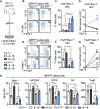PU.1 is required to restrain myelopoiesis during chronic inflammatory stress
- PMID: 37497478
- PMCID: PMC10368259
- DOI: 10.3389/fcell.2023.1204160
PU.1 is required to restrain myelopoiesis during chronic inflammatory stress
Abstract
Chronic inflammation is a common feature of aging and numerous diseases such as diabetes, obesity, and autoimmune syndromes and has been linked to the development of hematological malignancy. Blood-forming hematopoietic stem cells (HSC) can contribute to these diseases via the production of tissue-damaging myeloid cells and/or the acquisition of mutations in epigenetic and transcriptional regulators that initiate evolution toward leukemogenesis. We previously showed that the myeloid "master regulator" transcription factor PU.1 is robustly induced in HSC by pro-inflammatory cytokines such as interleukin (IL)-1β and limits their proliferative activity. Here, we used a PU.1-deficient mouse model to investigate the broader role of PU.1 in regulating hematopoietic activity in response to chronic inflammatory challenges. We found that PU.1 is critical in restraining inflammatory myelopoiesis via suppression of cell cycle and self-renewal gene programs in myeloid-biased multipotent progenitor (MPP) cells. Our data show that while PU.1 functions as a key driver of myeloid differentiation, it plays an equally critical role in tailoring hematopoietic responses to inflammatory stimuli while limiting expansion and self-renewal gene expression in MPPs. These data identify PU.1 as a key regulator of "emergency" myelopoiesis relevant to inflammatory disease and leukemogenesis.
Keywords: PU.1; hematopoiesis; hematopoietic progenitor cell; hematopoietic stem cell; inflammation; myelopoiesis.
Copyright © 2023 Chavez, Rabe, Niño, Wells, Gessner, Mills, Hernandez and Pietras.
Conflict of interest statement
The authors declare that the research was conducted in the absence of any commercial or financial relationships that could be construed as a potential conflict of interest.
Figures





References
Grants and funding
LinkOut - more resources
Full Text Sources
Molecular Biology Databases

